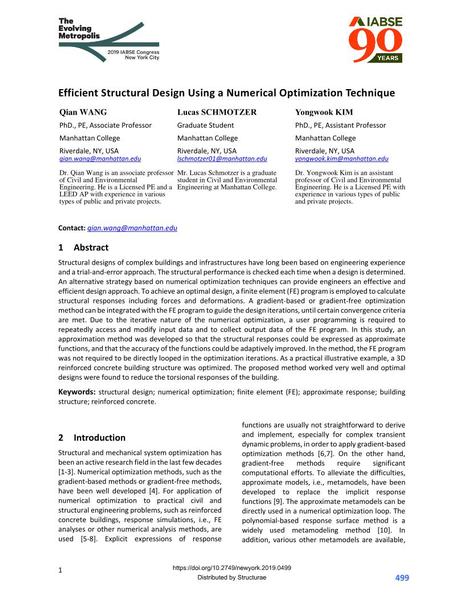Efficient Structural Design Using a Numerical Optimization Technique

|
|
|||||||||||
Bibliographic Details
| Author(s): |
Qian Wang
(Manhattan College)
Lucas Schmotzer (Manhattan College) Yongwook Kim (Manhattan College) |
||||
|---|---|---|---|---|---|
| Medium: | conference paper | ||||
| Language(s): | English | ||||
| Conference: | IABSE Congress: The Evolving Metropolis, New York, NY, USA, 4-6 September 2019 | ||||
| Published in: | The Evolving Metropolis | ||||
|
|||||
| Page(s): | 499-503 | ||||
| Total no. of pages: | 5 | ||||
| DOI: | 10.2749/newyork.2019.0499 | ||||
| Abstract: |
Structural designs of complex buildings and infrastructures have long been based on engineering experience and a trial-and-error approach. The structural performance is checked each time when a design is determined. An alternative strategy based on numerical optimization techniques can provide engineers an effective and efficient design approach. To achieve an optimal design, a finite element (FE) program is employed to calculate structural responses including forces and deformations. A gradient-based or gradient-free optimization method can be integrated with the FE program to guide the design iterations, until certain convergence criteria are met. Due to the iterative nature of the numerical optimization, a user programming is required to repeatedly access and modify input data and to collect output data of the FE program. In this study, an approximation method was developed so that the structural responses could be expressed as approximate functions, and that the accuracy of the functions could be adaptively improved. In the method, the FE program was not required to be directly looped in the optimization iterations. As a practical illustrative example, a 3D reinforced concrete building structure was optimized. The proposed method worked very well and optimal designs were found to reduce the torsional responses of the building. |
||||
| Keywords: |
structural design reinforced concrete finite element FE building structure numerical optimization approximate response
|
||||
